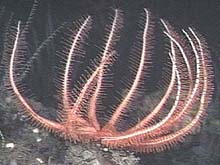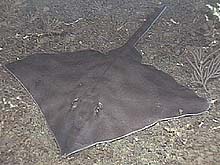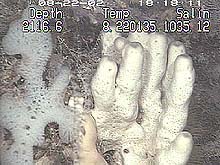Rocked by Mother Ocean
August 25, 2002
Paula Keener-Chavis, National Education Coordinator/Marine BiologistNOAA Office of Ocean Exploration
“From birth, Man carries the weight of gravity of his shoulders. He is bolted to Earth. But man has only to sink beneath the surface and he is free. Buoyed by water, he can fly in any direction…up, down, sideways. Underwater, Man becomes Archangel.” -- Jacques Cousteau
The compartment is small and egg-shaped, about 3.5-feet wide by seven feet long. You climb in through the lower hatch, and sit in the back near the CO2 scrubber. You feel the warm air blowing in on your back. Another passenger climbs up through the lower hatch, an Aft Observation Compartment (AOC) Tender, who will be your sole companion over the next three to four hours. His job is to monitor the depth, temperature, and quality of air inside the back compartment of the tiny Johnson-Sea-Link II submersible. Two other passengers, the pilot and the Chief Scientist, are seated in the front sphere of the submersible. You communicate briefly with them via the headset that is given to you by the AOC Tender.
The safety and emergency ascent procedures are reviewed and you are told there is enough air and food for a survival period of five days in the unlikely event of an emergency. You are asked if you are claustrophobic, and you reply “no,” as the hatch is pulled upward using a rope that dangles from its handle. A fleeting moment of slight claustrophobia races through your body as the hatch is sealed with a dull, clanky ‘thud.’
You feel vibrations and hear muffled high- pitched sounds as the submersible is connected to the lift line on the A-frame that will lift you and your companions up from the submersible cradle and over the stern of the research vessel Seward Johnson. You feel a slight jolt and then gentle rocking as you are slowly lowered onto the surface of the Atlantic Ocean. Then you are set free - free to slowly fall to the bottom of the ocean. You lay on your right side, with your steno pad and pen in hand, and bend your head down so as to peer through the starboard view port. You realize that the submersible has been swallowed by the ocean and the world as you know it has disappeared quickly from view. Crystal clear water and tiny bubbles are all you see through the view ports.
Within a few seconds, you know first-hand where the name for the color ‘aquamarine’ comes from. As the submersible continues on its descent to an area of the ocean floor not previously seen by human eyes, the aquamarine color transforms itself into a remarkable color of blue unlike any you have ever seen on Earth. It somehow seems timeless and eternal, having no beginning or end. By the time you reach a depth of 1,629 feet, the water is the color of the night sky during a new moon - a deep, dark midnight blackish blue. You begin to see tiny flashes of light through the view port, tiny twinkles of light that flash like petite falling stars, except they are moving upward as you continue your descent to the seafloor. A few ‘star flashes’ move sideways across the view port, as tiny gelatinous organisms create a most magnificent bioluminescent light dance as they welcome you to their ocean realm.
After about 20 minutes of what seems like ‘free fall,’ you reach the ocean bottom at 2,347 feet. The pilot carries you toward the west against a 0.3-knot current in 35 feet of visibility created by 2,910-watt shower of light from the submersible. You see beautiful sponges, corals, bryozoans, and an occasional crab or fish as you begin your slow ascent up from the base of a 387-foot coral pinnacle.
As the Chief Scientist, Dr. Shirley Pomponi, directs pilot (and husband) Don Liberatore to collect samples, she calls back to you over the headset and describes in detail the specimens being collected, the depth, and a general description of the area. White cup sponges, numerous corals, and another sponge known to produce a large number of bioactive compounds are gently scooped up by the manipulator arm and carefully placed in rotating sample collection buckets. You feel your body gently tilt forward as the submersible noses slightly downward to collect samples tucked away in crevices and sequestered under rock ledges. Sample No. 5 is placed in collecting bucket No. 6 and the sample collection ritual continues.
The words “beautiful,” “soft,” “encrusting,” “porous,” “abundant,” “hexactinellid,” “lithistid,” and ‘irregular” are adjectives selected by Pomponi to describe what she sees. You see the rare and endangered bright orange “black coral” out of the portside view port just as you realize that the right half of the submersible is suspended over the top of the ridge plateau and the other half over the abyssal blackness of the steep drop off created by the ridge wall. You continue to “cruise the edge of the ridge at a depth of 2,060 feet – beautiful corals and sponges amongst coral rubble out the view port to your right and a black void out the view port to your left.
As the current picks up to almost a knot, it bumps the submersible against the rocky ledge. You hear the pilot over the speaker call to the Seward Johnson, “We are at 2,059 feet, we have completed collections, and we request permission to leave the bottom.” A scratchy voice comes back over the radio, the pilot replies, “I cannot copy you. We are leaving the bottom.”
It’s like the slow dawning of a cold day….the blackness of the night slowly changing to the early morning sky. The tiny graceful creatures replay their bioluminescence welcome dance in reverse and the deep aquamarine color reappears only to slowly change into the crystal clear blue water that seems to be boiling with thousands of tiny air bubbles. You sit cradled in the submersible as if it was a life-support cocoon being gently rocked at the surface by Mother Ocean. It’s been three hours and 35 minutes since you left the surface, and you have returned to the world from whence you came…..enlightened, invigorated, liberated, humbled, and more passionate about the ocean than you ever dreamed you could be.
Sign up for the Ocean Explorer E-mail Update List.

















































